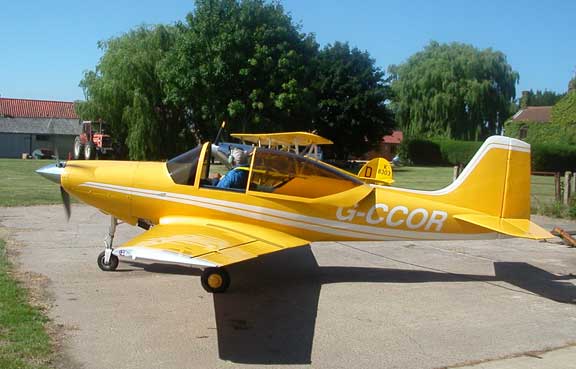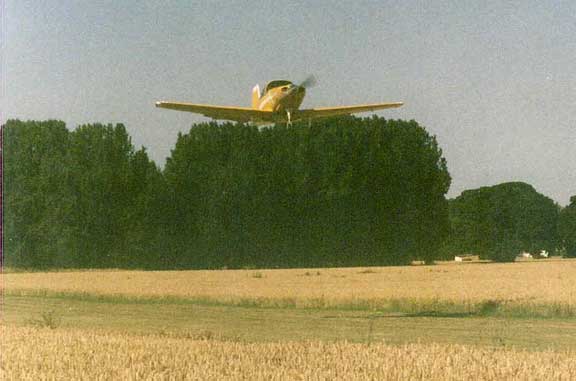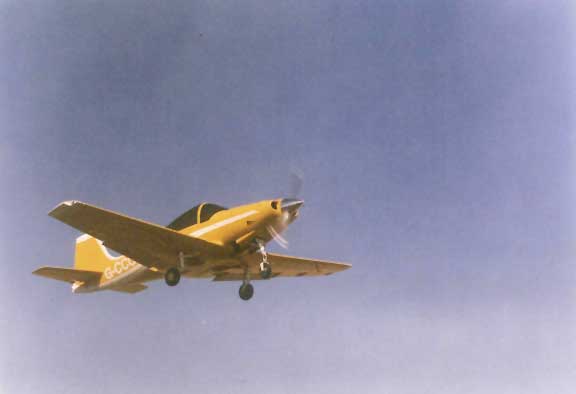Dave Thomas
![]()
Dave Thomas |
|

|
Ready to go |
Peter tells me that the gear wouldn’t go up (it’s probably the pressure switch, so we fit a jump for now), we inspect the plane, and everything is OK apart from the pressure switch and the radio. Peter says, “I suppose we could go again—jump in.” I’m not sure I’m ready, and I’m glad that Peter is the pilot. Off we go. We’re in the air after about 300 yards, we press the gear actuator fuse in and Peter flicks the switch Up. Up comes the gear and in no time we are at 3,000 feet in clear blue sky. 25/25 gives about 150 knots on this flight.
The left wing is heavy, and it needs a trim tab. Peter nudges me, and it’s my turn to take the controls whilst Peter takes notes. ‘Funny, G-CCOR feels just like G-PDGG, Peter’s own Series 3 Falco’. I can’t tell the difference between the fabric controls on my Falco and the metal ones on Peter’s. Turns are a breeze and a small descent sees the airspeed climbing to an indicated 180 knots.
With undercarriage and stall tests completed, I find myself in the circuit, set up for my first landing in my Falco (and all from the right hand seat). We arrive over the threshold at about 70 knots, and we are down safely.

|
The Falco breaks ground My Falco F8L registered G-CCOR made its first flight on Sunday 17th July. The first flight was from 600 yd Jubilee Farm strip and into Fenland Airfield, where I have had a hanger space reserved for about the last two years! The first series of flights have been carried out by Peter Grist who is listed on the test flight schedule along with myself. Peter started the project with Mike Pepper around 1982. That makes it a 23-year build, passing through a total of 5 owners in that period. I wonder if this a record. I am very pleased that Peter made the first flight since the arrangement has perfect symmetry (like the aeroplane), and we could have had no one better for the job. Peter has been very helpful and has allowed me sufficient stick time in his Series III Falco G-PDGG to apply for and be the test pilot for my own plane. However, I felt his expertise made the day. Dave Thomas |
The stall tests show classic behaviour with significant airframe buffet from about 65 kts (flaps up) and in the one-g stall the airframe breaks level with a pitch down. If held just off the break she nods forward and back whilst a large rate of descent builds up. Use of the flaps reduces the stall to around 55 kts. I had measured the stall strips on Peter’s Falco (which also displays this type of behaviour) and put mine in exactly the same place.
I ask Peter if he has time to undertake one more flight test, this time with a different flight test observer. Sian, my wife, has never flown a Falco and doesn’t know what to expect. Most of her flying is on a Jodel D119 which we rebuilt nearly ten years ago and then Sian learnt to fly on. After a half-hour flight I’m pleased to report that the Falco passed muster. Sian likes it, but will need to get used to not pulling so much elevator in the turns! She comments flying the Falco is like ballet.
The end of the day comes with G-CCOR in her new hangar looking quite resplendent in yellow, and definitely a flying machine. As predicted so long ago, we now have both aeroplanes Romeo and Juliet in the same hangar, one behind the other. My friend Frank is however determined to prepare the grain shed at Jubilee Farm to receive G-CCOR after harvest, as he states the plane is so complicated there will be further work to do this winter. He is certainly partly right—there are still the front gear doors to fit, and maybe more on a snagging list, we wait to see.

|
Climbing out |